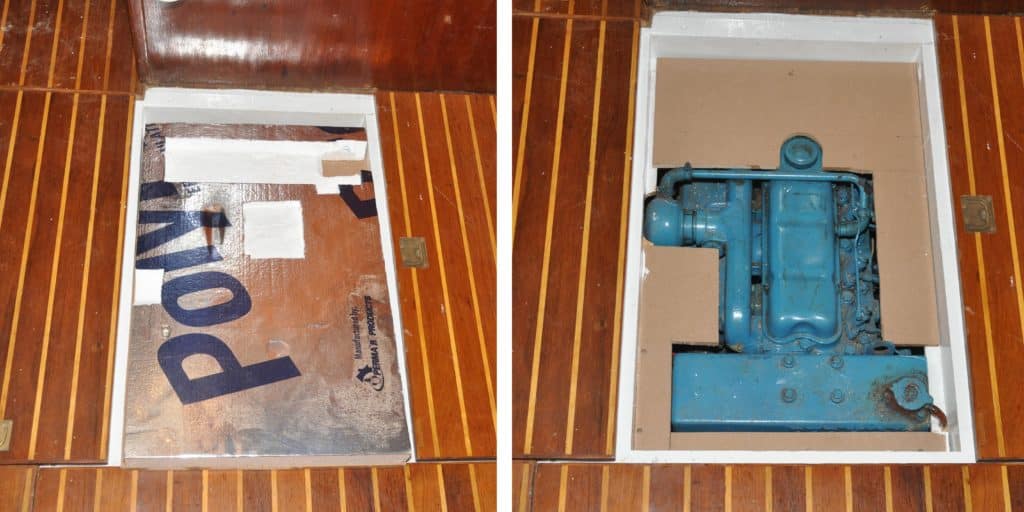
The engine in my 1977 Down East 45 schooner, Britannia, is a tried and trusted — but noisy — Perkins 4-236, an 85-horsepower four-cylinder diesel. There are also a Kubota three-cylinder diesel generator, five electric pumps and two bilge air blowers, all under the cabin sole.
I call the space the equipment bay. It runs 12 feet under the saloon floorboards and is 3 feet wide at the sole level, then tapers to just 15 inches at the bottom of the 41⁄2-foot-deep bilge. Seven removable floorboards give amazing access to all the equipment below, but the large space also acts as a massive boombox.
I previously had restored the teak-and-holly sole to its original beauty throughout the whole boat, but this made no difference to the noise level from the machinery below. When both diesels and extractor blowers were running, it was very noisy in the saloon, with a dull drumming you could almost feel. So I decided to do something about it.
There are a number of products that claim to significantly reduce noise from machinery, and some are specifically designed for boats. The trouble with most of these is they are also specifically aimed at your bank balance! For a boat my size, I found prices ranging from $350 for simple ¾-inch foam to $800 or more for double-thickness sound-insulation sandwiches.
In simple terms, the object of sound insulation is to absorb noise at its source, and thereby minimize what filters into the interior of the boat. It would be practically impossible to eliminate this altogether, but I had effectively reduced the engine noise from a similar diesel on a previous boat simply by installing a false floor beneath the cabin sole. This is quite an easy and inexpensive do-it-yourself way to achieve a significant increase in peace and quiet.
Before I started work on Britannia, I wanted to take a reading of the sound levels to have a numerical comparison after the modifications were complete. I downloaded a neat iPhone app, a decibel meter by Decibel Meter Pro, for the vast sum of 99 cents, from iTunes. It was very easy to use, and I took readings at head height in the center of the saloon. With the main engine running at cruising speed, the meter registered 85 db. Then I started the generator as well, along with the twin extractor fans. The level went up to 93 db, which is roughly equivalent to a power lawn mower. When the freshwater pump was activated, it added another few decibels. I don’t know how accurate these readings actually are, but it doesn’t really matter because what I wanted was a comparison of before and after sound levels.

Fitting the False Floor
To get started, it was first necessary to make support battens for the false floor panels to lie in, under the existing plywood sole. I bought a 24-by-48-inch sheet of ½-inch plywood and cut it into 4-inch-wide strips with my table saw. I also made ¾-inch square battens out of hardwood. It was necessary to reposition some pieces of equipment fastened to the sides of the floor beams, such as wire hangers, water pipes and the big main engine filter. They all needed to be lower than the new floor. The 4-inch-wide plywood strips were then screwed to the underside of the 2-inch-wide floor beams, forming a 1-inch lip on either side.
I screwed the ¾-inch square battens to the sides of each aperture to support the ends of the false floors. I painted the beams and all the new timbers white.
I found some medium-density fiberboard (MDF) at Home Depot that cost $25.95 for an 8-by-4-foot ½-inch sheet. I calculated that I’d need two to make the seven false floors. MDF is a heavy manufactured board similar to particleboard but smooth on both sides, with a density of 44 pounds per cubic foot. It’s used to make stereo-speaker boxes and other things for which sound control is required.
The sound-deadening properties of a ½-inch-thick sheet are actually better than the ¾-inch-thick marine plywood sole, which is roughly 35 pounds per cubic foot. (The MDF sheets were also available in ¾-inch thickness but would have been heavier and more expensive. In the end, I decided to compromise between weight, density and price, and go for the thinner stock.)
One problem to be aware of with this type of manufactured boards is their susceptibility to deterioration in damp conditions. If there is a chance they might become wet, it would be better to use marine plywood, though it’s much more expensive. A store employee cut the MDF sheets to the sizes I needed using a vertical circular saw. This saved me having to manhandle them out to the car, and enabled them to fit in my vehicle. I had them cut half an inch smaller than the spaces between the individual beams to prevent them jamming when I needed to lift them out to gain access to the bilge. A few boards still needed trimming to fit round obstructions that I could not reposition, but that was easy to do with my jigsaw.
The simplest, time-honored method to handle boards covering apertures is to cut a hole in the board big enough to get a couple of fingers through to lift it in and out. But these MDF boards were too big and heavy for that, and it would also have allowed a little bit more noise and heat to escape. I therefore drilled 3⁄8-inch holes in each board and threaded some 3⁄8-inch-diameter rope through them, knotting it on the underside to form simple handles to easily lift the boards in and out.
The weight of the new fiberboards was 60 pounds, but it’s all positioned low in the hull, and it was a small price to pay for reducing the noise. When lying between the beams, their weight also keeps them firmly in place. The sole and subfloor now has a combined thickness of 1¼ inches, with a density of about 80 pounds per cubic foot.

Beat the Heat
To complete the project, there was one more thing I wanted to do. We could often feel heat permeating through the single-thickness cabin sole when either of the diesel engines had been running a long time, especially on our own soles when walking barefoot. There must have been some sort of insulation glued to the underside of the floorboards at one time, but this had disintegrated. What was left was a dirty layer of dry adhesive that had to be scraped off by hand using Goof Off adhesive remover and a sharp 1½-inch chisel. I then painted the underside of the floorboards white.
To reduce the heat, I decided to add a layer of thermal insulation in the space between the subfloor and sole.
I bought two 4-by-8-foot sheets of Rmax Thermasheath R6 foam-board insulation from Lowe’s for $21.98 each. These are 2 inches thick, with aluminum foil on one face and an insulation rating of R6, which is the highest available for this thickness of foam. I cut them to the sizes I needed at the store using a sharp knife, which helped me fit them in my car. I then glued them to the underneath of each plywood floorboard using cheap construction adhesive by Liquid Nails; it was only $1.95 for a 10-ounce caulking-gun cartridge. This adhesive does not melt the foam.
The section of floor around the Perkins engine was particularly awkward because parts of the top of the engine were higher than the bottom of the floor beams. In fact, the valve cover was only an inch below the sole. This was, of course, the principal source of all the noise, so it needed special attention anyway.
I fitted battens all around the engine as I had in all the other openings, then shaped pieces of fiberboard to fit around the engine as well.
Next I cut pieces of foam and fiberboard to the size of the aperture and pressed the foam down over the engine with the fiberboard on top by actually standing on them. This indented the soft foam with an exact pattern of the high points of the engine, which I then cut out of the foam with a sharp blade. I glued what remained to the fiberboard, which then fit snugly under the removable piece of sole.
The remainder of the floor now had the ¾-inch plywood sole pieces, with 2 inches of foam glued underneath, then a ½-inch air gap, then the ½-inch MDF false floor. It was now certainly a compact floor.
After all this backbreaking work, I was naturally keen to take new readings on the decibel meter. With only the main engine running at the same revolutions per minute as before, my iPhone app meter read 65, a reduction of 20 db! Adding the generator raised this to 70 db, 23 db less than before and now about equivalent to an electric sewing machine. This reduction may not sound like much (forgive the pun), but decibel ratings are logarithmic, so the noise reduction is very noticeable. Now we can comfortably listen to the television or music at anchor, even with the generator running.
In addition to a considerable reduction in noise, there is now no perceptible heat coming through the floorboards, which helps to keep the living area cooler. Heat is carried outside by the engine-room extractor fans, and the noise from them is much reduced too.
Most projects I have undertaken on Britannia resulted in visible improvements, most notably when I renovated the teak-and-holly sole. The noise-and-heat-abatement project, on the other hand, showed no outward improvements, and the cabin looked exactly the same as before I started the job. It was only when the engines were running that the improvement was appreciated.
This method of sound insulation would be very worthwhile for any boat, offering excellent noise reduction for minimal financial outlay. I actually used some spare pieces of MDF to double the wall thickness in the spaces where my two air-conditioning units were installed, and this reduced the noise of the compressor and fan as well.
There are, of course, no labor charges factored into the cost of the job, which took me four days to complete, but messing about on boats is supposed to be fun.








